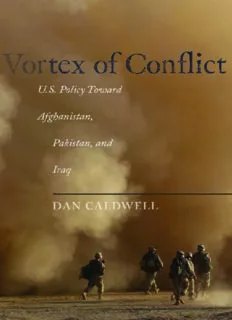
Vortex of Conflict: U.S. Policy Toward Afghanistan, Pakistan, and Iraq PDF
Preview Vortex of Conflict: U.S. Policy Toward Afghanistan, Pakistan, and Iraq
Vortex of ConfliCt Vortex of ConfliCt U.S. Policy Toward Afghanistan, Pakistan, and Iraq Dan CalDwell stanford security studies An Imprint of Stanford University Press Stanford, California Stanford University Press Stanford, California © 2011 by the Board of Trustees of the Stanford leland Junior University. all rights reserved. no part of this book may be reproduced or transmitted in any form or by any means, electronic or mechanical, including photocopying and recording, or in any information storage or retrieval system without the prior written permission of Stanford University Press. library of Congress Cataloging-in-Publication Data Caldwell, Dan (Dan edward), author. Vortex of conflict : U.S. policy toward afghanistan, Pakistan, and Iraq / Dan Caldwell. pages. cm. Includes bibliographical references and index. isbn 978-0-8047-7665-3 (cloth : alk. paper) — isbn 978-0-8047-7666-0 (pbk. : alk. paper) 1. United States—Foreign relations—2001–2009. 2. afghan war, 2001–. 3. Iraq war, 2003–. 4. war on Terrorism, 2001–2009. 5. United States— Military policy. I. Title. e902.c34 2011 973.93—dc22 2010045290 Printed in the United States of america on acid-free, archival-quality paper. Typeset at Stanford University Press in 10/14 Minion. Special discounts for bulk quantities of Stanford Security Studies are available to corporations, professional associations, and other organizations. For details and discount information, contact the special sales department of Stanford University Press. Tel: (650) 736-1782, Fax: (650) 736-1784 To those who have served in Afghanistan and Iraq and their families, With appreciation and gratitude Contents Preface and acknowledgments xi Part I HISTory 1 From Cold war to war on Terror 3 2 The United States and Islamic Countries 9 3 afghanistan, Pakistan, and the United States 30 4 Iraq: From Cradle of Civilization to republic of Fear 53 5 The Development of Terrorism, 1991–2001 71 6 The Bush Doctrine 91 Part II ISSUeS 7 assumptions 111 8 Intelligence 127 9 war Plans 153 10 Postwar reconstruction 171 11 Policymaking 189 12 allies 207 13 Strategy 225 Part III ConClUSIon 14 lessons and legacies: Twenty-Six articles 247 aPPenDIxeS a Maps of afghanistan, Pakistan, Iraq, and the Middle east region 269 B Chronology 274 Contents C Bibliography 288 Terrorism, Counterterrorism, and Counterinsurgency 288 afghanistan and Pakistan 294 The Iraq war 304 notes 335 Index 379 viii tables 2.1 Shia Population by Country 12 2.2 U.S. Petroleum Imports by Country of origin, 1970–2008 27 3.1 Statistical Profiles of afghanistan and Pakistan, 2010 34 3.2 afghan Mujahideen Groups, leaders, and Supporters 43 3.3 aid requested and received for afghanistan, 1996–99 46 4.1 Statistical Profile of Iraq in 1990 57 5.1 Chronology of al Qaeda attempted and actual Terrorist acts, 1992–2010 80 10.1 Provisional reconstruction Teams (PrT) in afghanistan and Iraq 186 12.1 U.S. and Coalition Troop Deployments in Iraq, 2003–9 215 12.2 Percentage of respondents who View the U.S. Positively, September 2003 221 12.3 International Security assistance Force (ISaF) Deployments to afghanistan, January 2007, February 2010, and november 2010 223 ix
Description: